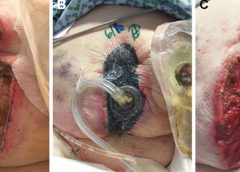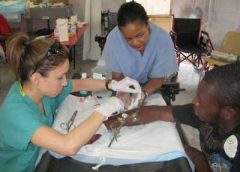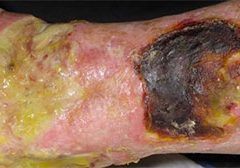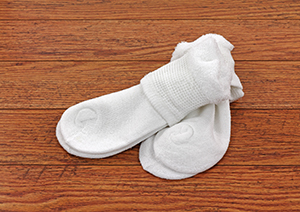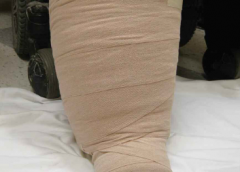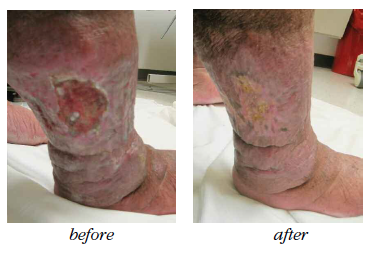Negative pressure wound therapy (NPWT) uses negative pressure to draw wound edges together, remove edema and infectious material, and promote perfusion and granulation tissue development. The tissue stretch and compression created by negative pressure during NPWT promotes tissue perfusion and granulation tissue development through angiogenesis, cellular proliferation, fibroblast migration, increased production of wound healing proteins, and reduction of wound area. NPWT has been used to improve healing in a variety of wounds, including traumatic injuries, surgical wounds, pressure ulcers, diabetic foot ulcers, and venous stasis ulcers. (more…)
Read MoreSearch Results for: compression
Clinical Notes: Modified Braden Risk Score, dialysis patients, plantar
Modified Braden risk score proposed
A study in Ostomy Wound Management states the risk classification of patients using Braden Scale scores should comprise three (rather than five) levels: high risk, with a total score ≤11; moderate risk, with a total score of 12 to 16; and mild risk, with a total score ≥17.
The retrospective analysis of consecutively admitted patients at risk for pressure ulcer to an acute-care facility included 2,625 patients, with an age range from 1 month to 98 years; 3.1% developed a pressure ulcer. (more…)
Read MoreStaying out of sticky situations: How to choose the right tape for your patient
By Ann-Marie Taroc, MSN, RN, CPN
Are you using the wrong kind of medical tape on your patients? Although we strive to provide the safest care possible, some nurses may not realize that medical tape used to secure tubes and dressings can cause harm. The harm may stem from using the wrong product or using a product incorrectly, which can cause adhesive failure or skin injury. (more…)
Read MoreIs your therapy department on board with your wound care team?
By Cheryl Robillard, PT, WCC, CLT, DWC
Patients in your clinical practice who develop wounds should prompt a call for “all hands on deck” to manage the situation, but some personnel may be missing the boat. Physical therapists (PTs), occupational therapists (OTs), and speech-language pathologists (SLPs) should be on board your wound care ship so patients can receive care they need. But unfortunately, sometimes they aren’t. (more…)
Read More2015 Journal: Best of the Best Vol. 4 No. 5
Clinical Notes
Mild compression diabetic socks safe and effective for lower extremity edema
Diabetic socks with mild compression can reduce lower extremity edema in patients with diabetes without adversely affecting arterial circulation, according to a randomized control trial presented at the American Diabetes Association 75th Scientific Sessions Conference. (more…)
Read MoreA collaborative approach to wound care and lymphedema therapy: Part 2
By Erin Fazzari, MPT, CLT, CWS, DWC
Have you seen legs like these in your practice?
These legs show lymphedema and chronic wounds before treatment (left image) and after treatment (right image) with complex decongestive therapy (CDT)—the gold standard of lymphedema care. The patient benefited from multidisciplinary collaboration between wound care and lymphedema therapists. (more…)
Read MoreComprehensive skin assessment
By Nancy Morgan, RN, BSN, MBA, WOC, WCC, DWC, OMS
Each issue, Apple Bites brings you a tool you can apply in your daily practice. Here’s an overview of performing a comprehensive skin assessment.
In the healthcare setting, a comprehensive skin assessment is a process in which the entire skin of a patient is examined for abnormalities. It requires looking at and touching the skin from head to toe, with a particular emphasis on bony prominences and skin folds. Comprehensive skin assessment is repeated on a regular basis to determine whether changes in the skin’s condition have occurred. The goal of a skin assessment is to identify problem areas promptly for treatment and prevention. (more…)
Read MoreCase study: Working under a time crunch in a short-stay facility
By Janet Wolfson, PT, CWS, CLT-LANA
After landing my dream job as the wound care coordinator at an inpatient rehabilitation facility (IRF), I found myself trying to determine how much healing could be achieved for our more challenging patients, given the constraints of reimbursement and what can be done in the typical 10 to 14 days of a patient stay.
Here’s an example of how I worked with our team to help one of these challenging patients. (more…)
Read MoreProviding evidence-based care for patients with lower-extremity cellulitis
By Darlene Hanson, PhD, RN; Diane Langemo, PhD, RN, FAAN; Patricia Thompson, MS, RN; Julie Anderson, PhD, RN; and Keith Swanson, MD
Cellulitis is an acute, painful, and potentially serious spreading bacterial skin infection that affects mainly the subcutaneous and dermal layers. Usually of an acute onset, it’s marked by redness, warmth, swelling, and tenderness. Borders of the affected skin are characteristically irregular. Although cellulitis may occur in many body areas, this article discusses the most common location—the lower limb. (more…)
Read MoreHelping patients with lower-extremity disease benefit from exercise
By Jeri Lundgren, BSN, RN, PHN, CWS, CWCN
Research has shown that exercise can help ease symptoms in patients with arterial insufficiency, venous insufficiency, neuropathic disease, or a combination of these conditions. Here’s what you need to know to ensure your patients reap the most benefits from exercise. (more…)
Read More
